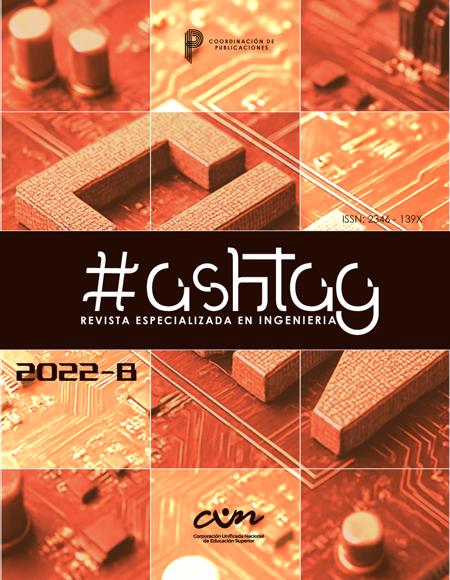Control de computadoras con 9 gestos de las manos usando una cámara web estándar
Computer control with 9 hand gestures using a standard webcam
Contenido principal del artículo
Resumen
La visión artificial, que automatiza la capacidad visual humana se ha convertido en un campo prometedor utilizado en diversos sectores, entre los cuales se encuentran implementaciones para la interacción humano-computadora sin necesidad de tocar sistemas de mando o periféricos externos. En este documento se presenta una solución que reconoce los gestos de las manos mediante el análisis de puntos de referencia tridimensionales en las articulaciones. Estos puntos se obtienen mediante el uso de una cámara web, y se utilizan como datos de entrada para una red neuronal artificial que identifica nueve gestos diferentes. Se diseñó una arquitectura de red, se creó un conjunto de datos propio y se entrenó la red. Además, se implementó un procesamiento previo de los datos para normalizar y transformar los puntos de referencia, mejorando así el rendimiento del modelo propuesto. La evaluación del modelo mostró una tasa de aciertos del 99,87% en el reconocimiento de los nueve gestos. En este trabajo se implementa dicho modelo en una aplicación llamada "Hand Controller", que permite controlar el teclado y el ratón de una computadora mediante gestos y movimientos de la mano, logrando un alto desempeño en el reconocimiento de los gestos de las manos en tiempo real.
Descargas
Detalles del artículo
Referencias (VER)
Chhibber, N., Surale, H. B., Matulic, F., & Vogel, D. (2021). Typealike: Near-keyboard hand postures for expanded laptop interaction. ACM on Human-Computer Interaction, 1-20.
Devlin, J., Chang, M., Lee, K., & Toutanova, K. (2019). BERT: pre-training of deep bidirectional transformers for language understanding. Proceedings of NAACL-HLT 2019, 4171–4186.
Hu, F., He, P., Xu, S., Li, Y., & Zhang, C. (2020). Fingertrak: Continuous 3d hand pose tracking by deep learning hand silhouettes captured by miniature thermal cameras on wrist. ACM on Interactive, Mobile, Wearable and Ubiquitous Technologies, 4, 1-24.
Hu, H., Zhao, W., Zhou, W., Wang, Y., & Li, H. (2021). Signbert: Pre-training of hand-model-aware representation for sign language recognition. 2021 IEEE/CVF International Conference on Computer Vision (ICCV), 11067–11076.
Joo, Y. R., Shiratori, T., & Hanbyul. (2021). FrankMocap: Fast Monocular 3D Hand and Body Motion Capture by Regression and Integration. ICCV Workshop 2021.
Kim, D. U., In Kim, K., & Baek, S. (2021). End-to-end detection and pose estimation of two interacting hands. In 2021 IEEE/CVF International Conference on Computer Vision (ICCV), 11169–11178.
Kim, Y., An, S.-G., Lee, J., & Bae, S.-H. (2018). Agile 3d sketching with air scaffolding. Conference on Human Factors in Computing Systems CHI'18, 1-12.
Lee, J. H., An, S., Kim, Y., & Bae, S. (2018). Projective windows: Bringing windows in space to the fingertip. Conference on Human Factors in Computing Systems CHI'2018, 1-8.
Liao, J., & Wang, H. (2019). Gestures as intrinsic creativity support: Understanding the usage and function of hand gestures in computer-mediated group brainstorming. ACM on Human-Computer Interaction, 1-16.
Liu, D., Zhang, L., & Wu, Y. (2022). Ld-congr: A large rgb-d video dataset for long-distance continuous gesture recognition. 2022 IEEE/CVF Conference on Computer Vision and Pattern Recognition (CVPR), 3294–3302.
Malik, Z. C., Radosavovic, I., Kanazawa, A., & Jitendra. (2021). Reconstructing Hand-Object Interactions in the Wild. International Conference on Computer Vision (ICCV).
Matulic, F., Arakawa, R., Vogel, B., & Vogel, D. (2020). Pensight: Enhanced interaction with a pen-top camera. Conference on Human Factors in Computing Systems CHI'20, 1-14.
Min, Y., Chai, X., Zhao, L., & Chen, X. (2019). Flickernet: Adaptive 3d gesture recognition from sparse point clouds. The British Machine Vision Conference (BMVC).
Min, Y., Zhang, Y., Chai, X., & Chen, X. (2020). An efficient pointlstm for point clouds based gesture recognition. 2020 IEEE/CVF Conference on Computer Vision and Pattern Recognition (CVPR), 5760–5769.
Osimani, C., Piedra Fernández, J. A., & Ojeda Castello, J. J. (2023). Point Cloud Deep Learning Solution for Hand Gesture Recognition. International Journal of Interactive Multimedia and Artificial Intelligence. doi:http://dx.doi.org/10.9781/ijimai.2023.01.001
Pei, S., Chen, A., Lee, J., & Zhang, Y. (2022). Hand interfaces: Using hands to imitate objects in ar/vr for expressive interactions. Conference on Human Factors in Computing Systems CHI ’22.
Qi, C. R., Su, H., Mo, K., & Guibas, L. J. (2017). Pointnet: Deep learning on point sets for 3d classification and segmentation. IEEE conference on computer vision and pattern recognition, 652–660.
Vaswani, A., Shazeer, N., Parmar, N., Uszkoreit, J., Jones, L., Gomez, A. N., . . . Polosukhin, I. (2017). Attention is all you need. Advances in Neural Information Processing Systems.
Weng, Y., Yu, C., Shi, Y., Zhao, Y., Yan, Y., & Shi, Y. (2021). Facesight: Enabling hand-to-face gesture interaction on ar glasses with a downward-facing camera vision. CHI ’21 Conference on Human Factors in Computing Systems, 1-14.
Zhang, F., Bazarevsky, V., Vakunov, A., Tkachenka, A., Sung, G., Chang, C.-L., & Grundmann, M. (2020). Mediapipe hands: On-device real-time hand tracking. Fourth Workshop on Computer Vision for AR/VR (CV4ARVR).
Zhou, Q., Sykes, S., Fels, S., & Kin, K. (2020). Gripmarks: Using hand grips to transform in-hand objects into mixed reality input. CHI ’20: Conference on Human Factors in Computing Systems, 1–11.








